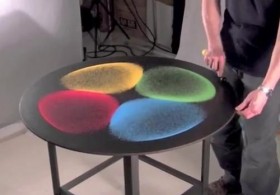Japanese performance artist Kenichi Kanazawa in Kyoto, Japan, via vibration frequencies fluctuation turns colored sand into an interactive work on a special table.
Kanazawa uses a simple rubber mallet and a scientific “sound-visualizing process” called Cymatics to create the detailed patterns.
Kanazawa uses a simple rubber mallet and a scientific “sound-visualizing process” called Cymatics to create the detailed patterns. To make the spectacle even stranger, the shapes shift in response to enhanced pitch: The higher the frequency, the more complex the patterns that emerge.
The process goes all the way back to the 1600’s, when Galileo Galilei was one of the first person to formally recognize that oscillating sounds could create patterns.
[adrotate group=”9″]
 Donald Trump says Zelensky ‘come back when he is ready for Peace’
Donald Trump says Zelensky ‘come back when he is ready for Peace’ Turkey Arrests Three Opposition Journalists
Turkey Arrests Three Opposition Journalists Ruyi Bridge: The spectacular wave bridge in China
Ruyi Bridge: The spectacular wave bridge in China The sunken holiday paradise that resurfaced
The sunken holiday paradise that resurfaced